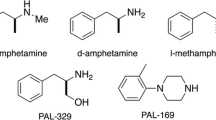Abstract
The discriminative stimulus properties ofd-amphetamine, cocaine, and apomorphine were assessed in rats trained in a two-lever, food-reinforced drug discrimination paradigm to discriminate 1.0 mg/kgd-amphetamine from saline. After determination of these dose-response relationships, the rats were divided into two groups. One group (6-OHDA) was given injections of desmethylimipramine (DMI, 30 mg/kg, IP) and 6-hydroxydopamine (6-OHDA, 100 μg/10 μl each ventricle), while the other group (sham) was given the same dose of DMI and 6-OHDA vehicle (intraventricularly). Beginning approximately 45 days after intraventricular injections, dose-response relationships were redetermined for all three drugs. Larger doses ofd-amphetamine were required to elicit the same response in the 6-OHDA group (i.e. the dose-response relationship was shifted to the right), while no change was observed in the sham group. Any changes in the dose-response relationships for cocaine and apomorphine were comparable in the 6-OHDA and sham group. The rate-decreasing effects were not altered in either group for any of the drugs. Upon sacrifice, dopamine (DA) was found to be significantly depleted in the accumbens, caudate and rest of brain of the 6-OHDA group. Levels of norepinephrine and serotonin were unaltered. These data suggest that central DA-containing neurons play a role in the discriminative stimulus properties of psychomotor stimulants in rats.
Similar content being viewed by others
References
Creese I, Iversen SD (1974) The role of forebrain dopamine systems in amphetamine induced stereotyped behavior in the rat. Psychopharmacologia 39:345–357
Creese I, Iversen SD (1975) Behavioral sequelae of dopaminergic degeneration: Postsynaptic supersensitivity? In: Usdin E, Bunney WE (eds) Pre- and postsynaptic receptors. Marcel Dekker, Inc., New York, pp 171–190
D'Mello GD, Stolerman IP (1977) Comparison of the discriminative stimulus properties of cocaine and amphetamine in rats. Br J Pharmacol 61:415–422
Garza R de la, Johanson CE (1985) Discriminative stimulus properties of cocaine in pigeons. Psychopharmacology 85:23–30
Heffner TG, Hartman JA, Seiden LS (1980) A rapid method for the regional dissection of the rat brain. Pharmacol Biochem Behav 13:453–456
Heffner TG, Zigmond MJ, Stricker EM (1977) Effects of dopaminergic agonists and antagonists on feeding in intact and 6-hydroxydopamine-treated rats. J Pharmacol Exp Ther 201:386–399
Ho BT, Silverman PB (1978) Stimulants as discriminative stimuli. In: Colpaert FC, Rosecrans JA (eds) Stimulus properties of drugs: Ten years of progress. Elsevier/North-Holland Biomedical Press, New York, pp 53–60
Kotake C, Heffner TG, Vosmer G, Seiden LS (1985) Determination of dopamine norepinephrine, serotonin and their major metabolic products in rat brain by reverse-phase ion-pair high performance liquid chromatography with electrochemical detection. Pharmacol Biochem Behav 22:85–89
McKenna ML, Ho BT (1980) The role of dopamine in the discriminative stimulus properties of cocaine. Neuropharmacology 19:297–303
Minnema DJ, Rosecrans JA (1984) Amphetamine and LSD as discriminative stimuli: Alterations following neonatal monoamine reductions. Pharmacol Biochem Behav 20:95–101
Ogren SO, Archer T, Johansson C (1983) Evidence for a selective brain noradrenergic involvement in the locomotor stimulant effects of amphetamine in the rat. Neurosci Lett 43:327–331
Schechter MD, Cook PG (1975) Dopaminergic mediation of the interoceptive cue produced byd-amphetamine in rats. Psychopharmacologia 42:185–193
Snoddy AM, Tessel RE (1983) Nisoxetine and amphetamine share discriminative stimulus properties in mice. Pharmacol Biochem Behav 19:205–210
Stolerman IP, D'Mello GD (1981) Role of training conditions in discrimination of central nervous system stimulants by rats. Psychopharmacology 73:295–303
Winter JC (1978) Drug induced stimulus control. In: Blackman DE, Sanger DJ (eds) Contemporary research in behavioral pharmacology, Plenum Press, NY, pp 209–237
Woolverton WL (1984) Pharmacological analysis of the discriminative stimulus properties ofd-amphetamine in rhesus monkeys. Pharmacologist 26:1621
Author information
Authors and Affiliations
Rights and permissions
About this article
Cite this article
Woolverton, W.L., Cervo, L. Effects of central dopamine depletion on thed-amphetamine discriminative stimulus in rats. Psychopharmacologia 88, 196–200 (1986). https://doi.org/10.1007/BF00652240
Received:
Revised:
Issue Date:
DOI: https://doi.org/10.1007/BF00652240




